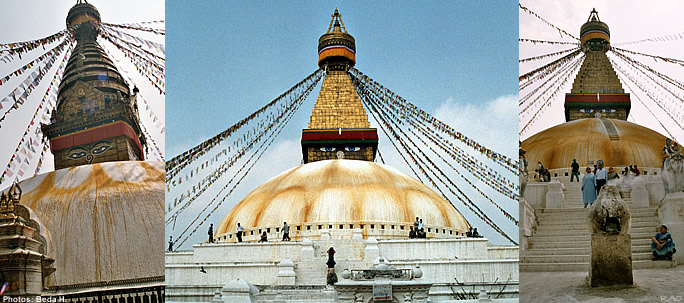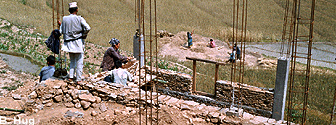 |
Nepal Tourist Destinations |
|
|
|
Nepal
has been a dreamland of the tourists since a long. Nepal invites, welcomes,
and bewilders the visitors. Those who have already visited Nepal cherish
the desire for the second visit and those who have heard or read about
the kingdom make a plan to visit Nepal.
Geographically,
Nepal is small country but she shines like a multi gem in her diversity.
She is holy, she is wonderful, she is gracious, she is strange, she is
wild and she is beautiful. The small geographical territory encapsulates
the most diverse of geo-topographical, biological and Socio-ethnic varieties.
In this country there stands the majestic Mt. Everest, fertile land of
the Terai sprawls luxuriously, deep George's and fountains spring up form
treasure house of the earth; swift and roaring rivers tumble down directly
from the Himalayas, many rare and beautiful species of plants and animal
find safe and favorable shelter in the land, the altitude of which varies
between 70 meters to 8848 meters. More importantly, more than 65 ethnic
groups speaking more than 45 languages present an unique example of the
harmony in the diversity. In short, people with different sets of interest
and different temperament find many things as their interest in the smallest
possible territory.
A
few highlighted places not to be missed with in the kingdom are as follows
...
Kathmandu City
The Kathmandu valley is the hub of Nepal for its' political, commercial and cultural activities and is the first stop for the majority of the visitors to the country. Once separate kingdom in itself, it consists of three cities of the great history. Every one has an artistic exposition of graceful temple, elegant palace, brick-paved courtyards and quaint streets.
The history begins with the Buddhist saint Manjushree who slashed a passage through the surrounding hills to drain out primordial water and made it habitable. Over the centuries, a refined urban civilization emerged, built on a unique synthesis of Hinduism and Buddhism. Dynasties came and went trade and the arts flourished. Its deeply religious Newars' inhabitants built fabulous cities and artistic temples that attracted devout pilgrims as well as ramping invaders. In the date late 18th century, following the founding of modern Nepal with in more or less the present boundaries, Kathmandu was made the capital. It is said that ‘Kathmandu' was named after Kastamandap an imposing pagoda next to Hanumandhoka palace. The city is said to built in its present form by Gunakama Dev 724 AD. Followings are the major tourist attractions in the Kathmandu Valley.
Durbar Square
This complex of palaces, courtyards, and temples are built on 12th to 18th centuries used to be the seat of the ancient Malla kings of Kathmandu. An intriguing piece here is the 17th century stone inscription set in to the wall of the palace with writing in 15 languages. The Durbar Square protected as an UNESCO World Heritage Site, is the social, religious and urban focal point of the city. There are three museums inside the palace building.
Swoyambhunath Stupa
This is one of the most glorious Buddhist Stupa, which is the oldest shrine of Kathmandu valley. Visitors often call it “Monkey Temple”. The Stupa is formed with a solid hemisphere of bricks and clay supporting lofty conical spire capped by a pinnacle of copper gilt. Painted on four sides of the spire are the all-seeing eyes of Lord Buddha. It is three kilometers west of Kathmandu and located on the hilltop nearly 700 meters above the sea level of the valley.
Pashupatinath Temple
One of then most sacred Hindu shrines of the world, Pashupati Nath lies 6 km east of Kathmandu City center. Is famous for its superb architecture with its two tired golden roof and silver doors. It is a center of annual pilgrimage of Mahasivaratri. The richly ornamented pagoda houses the sacred LINGA or phallic symbol of Lord Shiva. Chronicles indicate the temple's existence prior to 400 AD. Devotees can be seen taking ritual dips in the Holy Bagmati River following beside the temple, also a World heritage Site.
Bouddhanath Stupa
One of the world's largest Stupa, Boudha is generally acknowledged to be the most important Tibetan Buddhist monument outside Tibet. Tibetans simply call it CHORTEN CHEMPO "Great Stupa". It has now become the Mecca of Tibetan exiles in Nepal. Walking around Boudhnath one often fins men wearing long braids wrapped around their heads. Many of these pilgrims carry their own prayer wheels, which they spin incessantly.
Bhudhanilkantha
It is situated below Shivapuri hill at the northern end of the valley. It is about 10 km from the city venture. The hub of the temple is a pond, in which lies a great stone figure of the Hindu god Vishnu reclining on a bed of snakes. It is the 5th century statue during the Lichachhavi period.
| Courtesy of
Association for Tourism, Nepal |
 |
|


